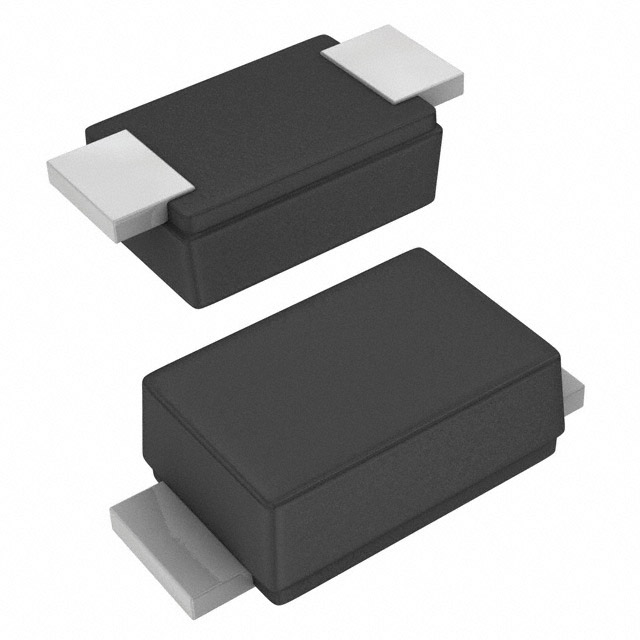SMF3.3
Introduction
SMF3.3 is a semiconductor product belonging to the category of transient voltage suppressors (TVS). It is widely used for protecting sensitive electronics from voltage transients induced by lightning, electrostatic discharge (ESD), and other transient voltage events. This entry provides an overview of SMF3.3, including its basic information, specifications, pin configuration, functional features, advantages and disadvantages, working principles, application field plans, and alternative models.
Basic Information Overview
- Category: Transient Voltage Suppressors (TVS)
- Use: Protection against voltage transients induced by lightning, ESD, and other transient voltage events
- Characteristics: Fast response time, low clamping voltage, high surge current capability
- Package: SOD-123FL
- Essence: Semiconductor device for voltage suppression
- Packaging/Quantity: Available in tape and reel packaging, quantity varies based on supplier
Specifications
- Voltage Rating: 3.3V
- Peak Pulse Power: 200W
- Operating Temperature Range: -55°C to +150°C
- Storage Temperature Range: -55°C to +150°C
Detailed Pin Configuration
The SMF3.3 package consists of three pins: 1. Pin 1: Anode 2. Pin 2: Cathode 3. Pin 3: No Connection (NC)
Functional Features
- Fast response time to clamp transient voltages
- Low clamping voltage to protect downstream components
- High surge current capability for robust protection
Advantages and Disadvantages
Advantages
- Effective protection against voltage transients
- Compact package size
- Wide operating temperature range
Disadvantages
- Limited to specific voltage rating
- Requires careful consideration of placement in circuit design
Working Principles
SMF3.3 operates based on the principle of avalanche breakdown, where it rapidly diverts excessive voltage away from sensitive components by conducting excess current during transient events. This action helps to limit the voltage across the protected circuit.
Detailed Application Field Plans
SMF3.3 finds extensive use in various applications, including: - Consumer electronics - Telecommunication equipment - Industrial control systems - Automotive electronics - Medical devices
Detailed and Complete Alternative Models
Some alternative models to SMF3.3 include: - SMAJ3.3A - P4SMAJ3.3A - SMBJ3.3A - SMCJ3.3A
In conclusion, SMF3.3 is a vital component in safeguarding electronic circuits from transient voltage events, offering fast response, low clamping voltage, and high surge current capability. Its application spans across diverse industries, making it an essential part of modern electronics.
Word Count: 324
Lista 10 Vanliga frågor och svar relaterade till tillämpningen av SMF3.3 i tekniska lösningar
What is SMF3.3?
- SMF3.3 stands for Service Management Facility 3.3, which is a feature in the Oracle Solaris operating system that manages system services and their dependencies.
How does SMF3.3 handle service management?
- SMF3.3 uses manifests to define how services should be managed, including their dependencies, start/stop methods, and error handling.
Can SMF3.3 restart failed services automatically?
- Yes, SMF3.3 can be configured to automatically restart failed services based on defined properties and dependencies.
What are the benefits of using SMF3.3 in technical solutions?
- SMF3.3 provides improved service management, dependency tracking, fault monitoring, and automatic recovery, enhancing system reliability and availability.
How can I create a new service manifest in SMF3.3?
- You can create a new service manifest by defining the service properties, dependencies, and actions in an XML file following the SMF schema.
Does SMF3.3 support customizing service behavior?
- Yes, SMF3.3 allows for customization of service behavior through property settings, method scripts, and fault management policies.
Can SMF3.3 integrate with monitoring and alerting systems?
- Yes, SMF3.3 can integrate with monitoring and alerting systems to provide notifications and responses to service failures or performance issues.
Is it possible to disable a service temporarily in SMF3.3?
- Yes, you can disable a service temporarily in SMF3.3 using the
svcadmcommand to prevent it from starting until re-enabled.
- Yes, you can disable a service temporarily in SMF3.3 using the
How does SMF3.3 handle service dependencies?
- SMF3.3 manages service dependencies by ensuring that required services are started before dependent services and handling cascading failures appropriately.
Are there any best practices for managing services with SMF3.3?
- Best practices for managing services with SMF3.3 include defining clear dependencies, implementing proper error handling, and regularly monitoring service health and performance.


